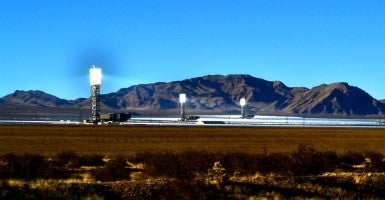As every 10-year-old who ever got a sweater for a birthday present has been told, “it’s the thought that counts.” That seems to be the guiding principle at the Department of Energy and the California Public Utilities Commission when it comes to solar power.
The latest example is the $2.2 billion Ivanpah solar thermal plant in California. (Note: Solar thermal plants do not use solar panels to directly convert sunshine to electricity; they use sunshine to boil water that then drives conventional turbines.)
Here’s the story so far. Ivanpah…
- is owned by Google, NRG Energy, and Brightsource, who have a market cap in excess of $500 billion.
- received $1.6 billion in loan guarantees from the Department of Energy.
- is paid four to five times as much per megawatt-hour as natural gas-powered plants.
- is paid two to three times as much per megawatt-hour as other solar power producers.
- has burned thousands of birds to death.
- has delayed loan repayments.
- is seeking over $500 million in grants to help pay off the guaranteed loans.
- burns natural gas for 4.5 hours each morning to get its mojo going.
Brightsource, which is privately held, is owned by a virtual who’s who of those who don’t need subsidies from taxpayers and ratepayers.
In spite of all this, Ivanpah has fallen woefully short of its production targets. The managers’ explanation for why production came up 32 percent below expected output is the weather. In addition to raising questions about planning for uncertainty, it is not all that clear how a nine-percent drop in sunshine causes a 32-percent drop in production.
More bizarrely, the natural gas used to get the plant all warmed up and ready each day would be enough to generate over one quarter of the power actually produced from the solar energy. Sorry, let’s not be haters.
The problem for Ivanpah’s customers (California power utilities) is that they planned on all those solar watt-hours to meet California’s renewable power mandates, which require that renewables produce a large and rising fraction of California’s electricity. That is why they pay so much more for Ivanpah’s output than for conventionally powered electricity.
Breaching their contracts with these California utilities threatened to shut down Ivanpah. More likely than permanently shutting Ivanpah down would have been a change of ownership at a price that came closer to reflecting reality.
But this would have been bothersome for Ivanpah’s investors and the Department of Energy’s ridiculous Section 1703 Loan Program, so the California Public Utilities Commission saved the day (for the fat-cat owners, of course, not for actual the electricity consumers) by granting the company an extension to meet the production targets.
The best part of the ruling is the section on the cost—it’s pretty succinct.
Here it is in its entirety:
But hey, Ivanpah’s plant is a shiny new technological marvel. That’s what counts, right?





























